Essential Guide to Choosing Livestock Fencing Posts
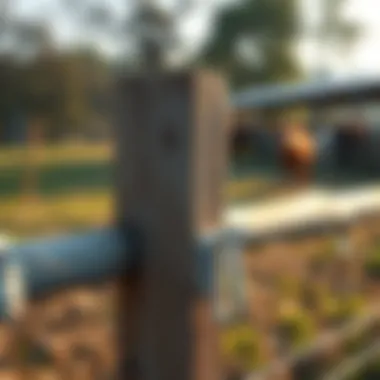
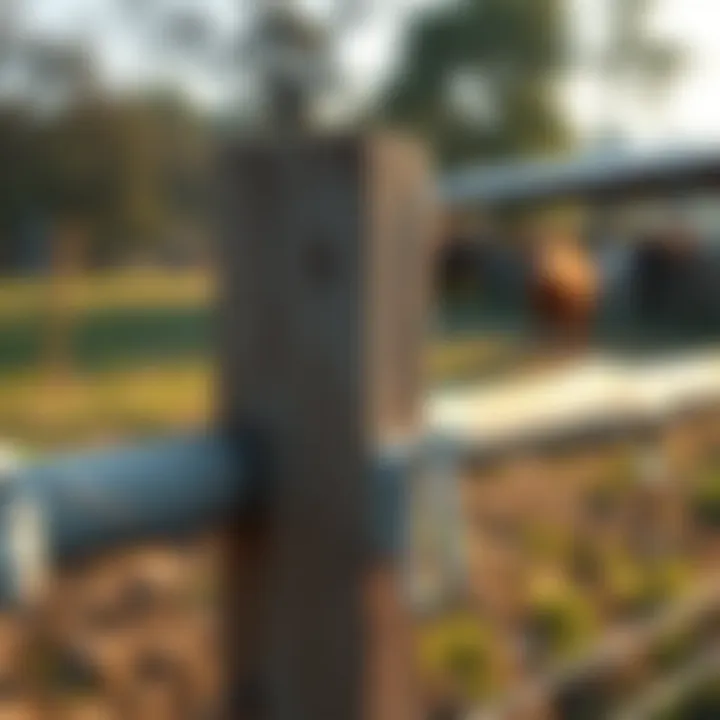
Intro
Livestock management plays a crucial role in modern agriculture, and within this sphere, fencing posts are often an overlooked but vital component. The effectiveness of a farm is heavily influenced by the quality of fencing systems, which not only enclose livestock but also protect crops and preserve pasturelands. As such, understanding the various materials, designs, and installation methods of fencing posts is essential for any farmer or enthusiast aiming for optimum productivity and animal welfare. This guide aims to provide farmers, whether seasoned pros or newcomers to the field, with in-depth insights into the art and science of livestock fencing posts.
Topic Overview
Definition and Importance
Fencing posts serve as the backbone of any fencing system. They are typically sturdy stakes fixed in the ground to support fencing wire or panels. In essence, these posts provide the structure needed to create secure enclosures for livestock, safeguarding animals from predators and preventing them from straying. Properly installed fencing not only enhances farm security but also aids in pasture management, allowing rotational grazing and improving soil quality over time.
Brief History and Evolution
Historically, the methods of fencing were quite rudimentary. Early farmers used rocks, wood, and even thorn bushes to keep their livestock contained. Over the years, the industry has seen a significant evolution in fencing technology. The introduction of materials like barbed wire in the late 19th century transformed the way farmers approached livestock management. Today, advancements in materials and design continue to shape the fencing landscape, making it more efficient, resilient, and cost-effective.
Key Techniques and Innovations
Sustainable Farming Practices
Modern farmers are increasingly turning towards sustainable practices that help minimize the environmental impact of livestock management. This includes choosing fencing materials that are environmentally friendly, such as recycled composite posts, which reduce waste and minimize the use of virgin materials.
"Sustainable fencing practices today help farmers strike a balance between productivity and environmental stewardship."
Advanced Agronomic Technologies
Technological advancements have introduced smart fencing solutions, integrating sensors and automation into traditional fencing systems. For example, solar-powered electric fencing can deter animals efficiently while using renewable energy sources. Moreover, digital monitoring systems can notify farmers of any breaches, ensuring quick responses to potential issues.
Practical Applications
Step-by-Step Guides
Selecting the right fencing post involves several steps. A simple guide includes:
- Assess your needs: Consider the type of livestock, their behavior, and the terrain of your land.
- Choose the right material: Options include wood, steel, vinyl, and composite materials, each with its strengths and weaknesses.
- Installation: Proper depth and spacing are crucial. Generally, posts should be buried at least a third of their length in the ground.
- Maintenance: Regularly inspect for wear and tear, especially after extreme weather events.
Case Studies or Real-World Examples
Consider a small farm in the Midwest that switched from traditional wooden posts to fiberglass composite. The change not only improved durability but also cut maintenance costs significantly. Local farmers report that composite materials resist rot and pests much better than their wooden counterparts, aligning well with both economic and environmental goals.
Closure
In summation, understanding the ins and outs of livestock fencing posts is imperative for anyone involved in agriculture today. By delving into materials, installation, and innovative practices, farmers can make informed decisions that enhance both their productivity and sustainability. Investing time in proper knowledge not only boosts efficiency but also ensures the well-being of livestock, ultimately leading to a more profitable and responsible farming practice.
For further insights, consider visiting resources such as Wikipedia, Britannica, or farmer forums on Reddit.
Understanding Livestock Fencing
In the realm of agriculture, particularly when it comes to livestock management, fencing plays a pivotal role. It is not merely a barrier that keeps animals contained; it’s the backbone of a safe and productive farming environment. Without proper fencing, livestock can roam freely, leading to various risks such as injury, loss, and even potential legal repercussions if animals stray onto neighboring properties.
The significance of livestock fencing can hardly be overstated. It fundamentally influences how effectively farmers can manage their animals. Properly constructed and well-maintained fences reduce stress among livestock, allowing them to thrive in a secured space. Livestock can exhibit more natural behaviors within their designated areas, and they are less likely to encounter accidents that could arise from wandering into hazardous zones.
Importance of Fencing in Agriculture
Fencing is an indispensable aspect of agricultural practices for several reasons:
- Safety and Security: It ensures the safety of both livestock and crops. When animals are contained, they are protected from predators and environmental dangers. At the same time, crops remain untouched and can grow to maturity without the risk of being grazed upon.
- Containment and Control: For farmers, controlling the movement of livestock is crucial. Effective fencing helps manage animal behavior, especially for herding breeds. It minimizes instances of aggression or panic among the livestock, reinforcing a more peaceful farming atmosphere.
- Regulatory Compliance: In some regions, local regulations dictate certain fencing requirements to keep livestock secure. Adhering to these laws not only protects animals but also shields farmers from potential legal issues. Non-compliance can result in hefty fines or other punitive actions.
- Economic Efficiency: Good fencing has a direct impact on the bottom line. By preventing livestock from escaping, farmers save on costs related to lost animals, extra feed, or healthcare issues that arise from injuries. In essence, a well-fenced farm can lead to higher productivity and reduced operational costs.
"An investment in quality fencing is an investment in the future of your farm."
Types of Livestock to Consider
When it comes to fencing, understanding the types of livestock being managed is essential. Each kind has distinct needs and behavioral traits that influence fencing decisions. Here are a few types to consider:
- Cattle: Generally large and strong, cattle require robust fencing. Materials like barbed wire or high-tensile wire can work well. The height of the fence should be considerable enough to prevent jumping, while the spacing should be tight enough to avoid nose poking.
- Sheep: More vulnerable than other livestock, sheep can easily slip through wide gaps. Fences for sheep should be higher with smaller spacing to prevent escape, often utilizing woven wire fencing.
- Goats: Known for their climbing abilities, goats need fencing that is both tall and secure, often necessitating additional top wires or barbed wire to keep them in check.
- Pigs: These animals can be quite adept at digging. Fencing for pigs may require knowledge of ground conditions, ensuring that posts are sunk deeply with a secure barrier that can't be burrowed beneath.
In sum, livestock fencing is a multifaceted issue that requires careful consideration of both the material and type of fencing suited to the specific livestock. The right decisions in fencing can lead to improved animal welfare, better yields, and a more effective farming operation overall.
Fencing Post Materials
When it comes to managing livestock effectively, the choice of fencing post materials holds significant weight. The right materials not only provide structural integrity but also contribute to the efficiency and safety of the entire fencing system. Selecting durable and suitable posts can be the difference between having a secure perimeter and facing frequent incursions or escapes, hence understanding the various materials and their properties becomes imperative.
Wooden Fencing Posts
Wooden posts have long been a favorite among farmers, and for good reason. They offer a rustic charm and are relatively easy to work with.
Advantages of Wood
An attractive feature of wooden posts is their natural versatility. They can adapt to various styles and settings, making them a go-to choice for many farms. The aesthetic appeal of wood cannot be overstated – it blends seamlessly with the scenic views of rural landscapes, which is a big plus for those who value aesthetics alongside functionality. Moreover, wooden posts are generally easier to install compared to metal alternatives, and with the right treatment, they can withstand elements well. The initial costs are often lower, which makes installing a wooden fencing system a more accessible option for many farmers.
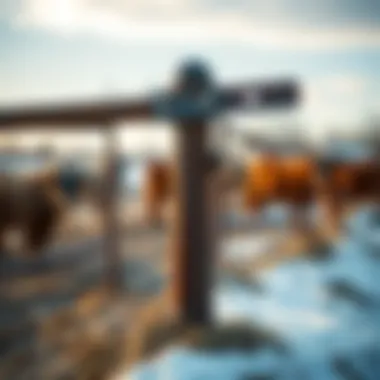
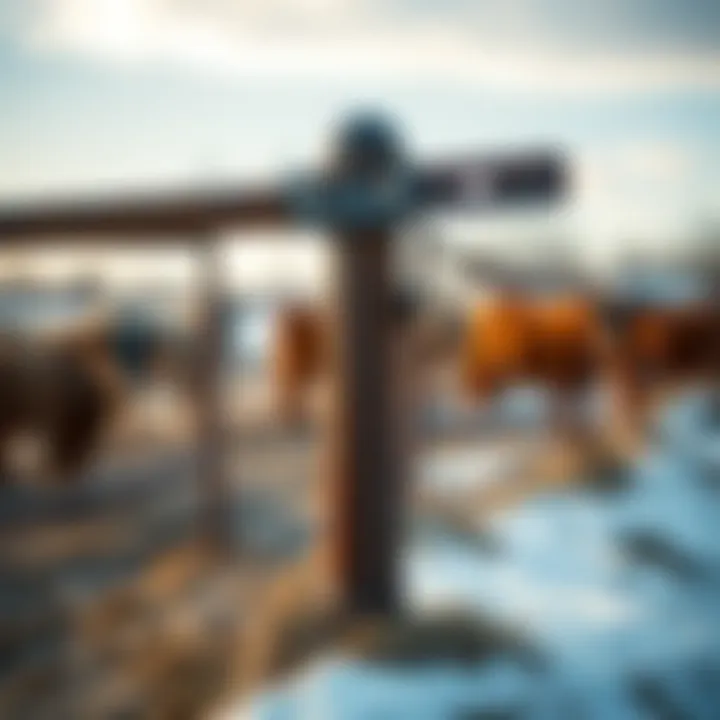
However, their aesthetic value does not overshadow practical considerations such as the ease of repairs. A broken wooden post can be replaced relatively quickly, allowing farmers to maintain their fencing systems without significant downtime.
Disadvantages of Wood
While wood has its perks, it’s not without its drawbacks. The most glaring issue is its susceptibility to rot and pests. Depending on the climate, wooden posts can deteriorate over time, requiring regular inspections and replacements. Farmers must also consider the potential impacts of moisture and insect infestations, which can undermine the strength of the fencing. Moreover, wooden posts generally have a shorter lifespan than their metal counterparts, meaning long-term costs can accumulate if they need frequent replacement. It’s essential to factor in these aspects when initially opting for wood, as maintenance and eventual replacements can become a burden if not planned for properly.
Steel and Metal Fencing Posts
For those looking for robust options, steel and metal posts stand out as resilient choices.
Durability Factors
Steel posts shine in terms of durability; their resistance to various environmental hazards makes them a prime selection for long-term fencing solutions. Unlike wood, steel is not affected by rot or insect damage, which means once installed, these posts can stand the test of time with little maintenance. Their strength is often enough to withstand heavy livestock and even adverse weather conditions without buckling. Thus, for farmers looking for reliability in their fencing systems, choosing metal can be a valuable investment.
The unique feature of metal posts lies in their ability to maintain structural integrity over the years. Unlike wood, you’re less likely to face an unexpected failure, which can be quite detrimental in managing livestock. This reliability makes them a popular choice among larger farming operations, where the stakes are considerably higher.
Cost Considerations
However, there’s a tradeoff. The initial investment in steel posts is significantly higher than that of wooden counterparts. For smaller farms or those with tight budgets, this could pose a challenge. Additionally, metal posts are often heavier and may require more effort during installation. This can add labor costs or necessitate the use of machinery to position them correctly.
While the upfront costs can be daunting, many farmers find that the long-term value is worth the price, as these robust structures often outlast wood by a mile, making them a less frequent expense over time.
Vinyl and Composite Posts
Vinyl and composite materials have been gaining popularity as alternatives to traditional wood and metal posts.
Longevity and Aesthetic Appeal
One of the main draws of vinyl fencing posts is their extraordinary longevity. Unlike wood, they won't rot, warp, or succumb to pests. This makes maintenance a breeze, encouraging farmers to invest in fencing systems that stand firm without the worry of constant repair. Additionally, vinyl posts come in various colors and designs, which can enhance the visual appeal of a property. For those looking to marry function and style, these posts certainly check both boxes.
The aspect of low maintenance is especially crucial for busy farmers. With vinyl posts, it’s often a “set it and forget it” scenario, as these structures generally require just an occasional rinse to keep them looking new. This factor, combined with their long-lasting nature, makes them an attractive option for those mindful of aesthetics and longevity.
Environmental Impact
On the other hand, the environmental impact of vinyl and composite materials is a concern for some. While they boast a long lifespan, the production processes for these materials can be energy-intensive and not entirely eco-friendly. Some farmers may wish to consider sustainably sourced options or look deeper into the composition of composite materials before making a decision. Furthermore, when they do reach the end of their lifespan, the disposal of vinyl can lead to environmental challenges, necessitating consideration for the long-term ecological footprint of one’s fencing choices.
"Selecting the right fencing post material is not just a matter of preference; it can significantly bolster farm safety and animal welfare."
Careful consideration of factors such as durability, cost, maintenance, and environmental impact will guide farmers in making informed decisions towards effective livestock management.
Designing an Effective Fencing System
Designing an effective fencing system is paramount in ensuring the safety and productivity of livestock management. A well-thought-out fencing system can significantly reduce the likelihood of livestock escape, minimize trespassing by wild animals, and provide a clear boundary that protects both the animals and the property. When setting up such a system, it’s vital to consider factors such as height, spacing, and gate integration, all of which play essential roles in the functionality and durability of the fence.
Choosing the Right Height and Spacing
Factors Influencing Height
The height of a fence is not just about aesthetics; it’s about keeping livestock secure and within boundaries. Several factors influence the height choice. For example, different species of livestock have varying tendencies to jump or lean against a fence. Horses often require taller fencing, generally ranging from five to six feet, because of their ability to leap. On the other hand, goats, with their natural climbing skills, may need fencing at least four feet high to prevent escapes.
Additionally, the local wildlife may dictate height. Areas with deer or coyotes would benefit from taller fences to deter these animals from attempting to breach the enclosure. Ultimately, a well-placed fence should serve as a reliable deterrent against both domestic and wild animals, preventing them from straying or invading. The considerable advantage here is that by choosing the right height, you reduce the risk of potential losses and ensure animal safety.
Spacing Guidelines
Spacing between posts is just as significant as the height. The common recommendation typically aims for eight to twelve feet between posts, depending on the type of fencing material used and the terrain. In hilly or uneven areas, closer spacing might be necessary to maintain stability. The key characteristic of following these spacing guidelines is to promote a stronger framework that resists the forces of nature, whether it be wind, snow, or the strain from livestock leaning against it.
Moreover, too wide of spacing may cause sections to sag over time, leading to costly repairs or replacements. Therefore, it is advantageous to invest the time in calculating the appropriate post spacing upfront. This foresight reveals its benefits down the road, ensuring that your fence remains upright and effective through the seasons.
Integrating Gates and Access Points
Placement of Gates
The placement of gates within a fencing system can turn a simple loop into a user-friendly layout. Ideally, gates should be positioned at locations that are easily accessible for machinery, livestock handling, or day-to-day movement within the farm. Their position can affect the efficiency of workflows and the overall livestock management. For instance, having gates too far from access points can lead to unnecessary hassle during feeding or medical check-ups.
A beneficial consideration is the use of double gates in high-traffic areas, allowing safe movement without bottlenecking. Proper gate sizing and sturdiness are also critical to resist the pressure from curious animals. A unique feature to note is that well-placed gates can streamline your routine, making not just the job easier but minimizing stress for both animals and handlers.
Access for Maintenance
Access for maintenance is crucial in ensuring the longevity and functionality of a fencing system. Planning pathways for easy entry allows for regular inspection and repairs, which are often overlooked but essential in averting more severe issues down the line. Unhindered access facilitates swift action during emergencies, such as if a section of the fence deteriorates.
It’s prudent to consider easy passageways for maintenance without disrupting the livestock. Features like removable panels can ease access while maintaining security. This focus on accessibility proves to be advantageous, as it encourages ongoing upkeep, leading to a robust fence that withstands various environmental stresses.
A well-designed fencing system integrates thoughtful height, spacing, and access considerations into a cohesive structure that enhances livestock management.
In the following sections, we'll delve deeper into installation techniques, maintenance routines, and the latest innovations in fencing technology.
Installation Techniques
Installation techniques are the backbone of a successful livestock fencing system. When it's done right, you not only create a secure barrier but also save yourself from future headaches and unexpected costs. So, understanding the key components of installation can make all the difference in both functionality and longevity of your fence.
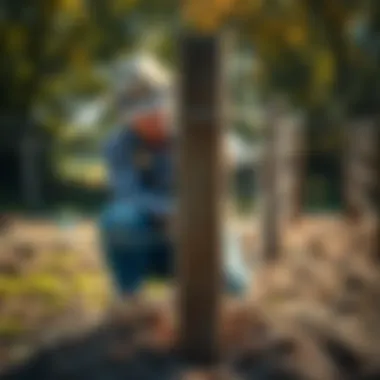
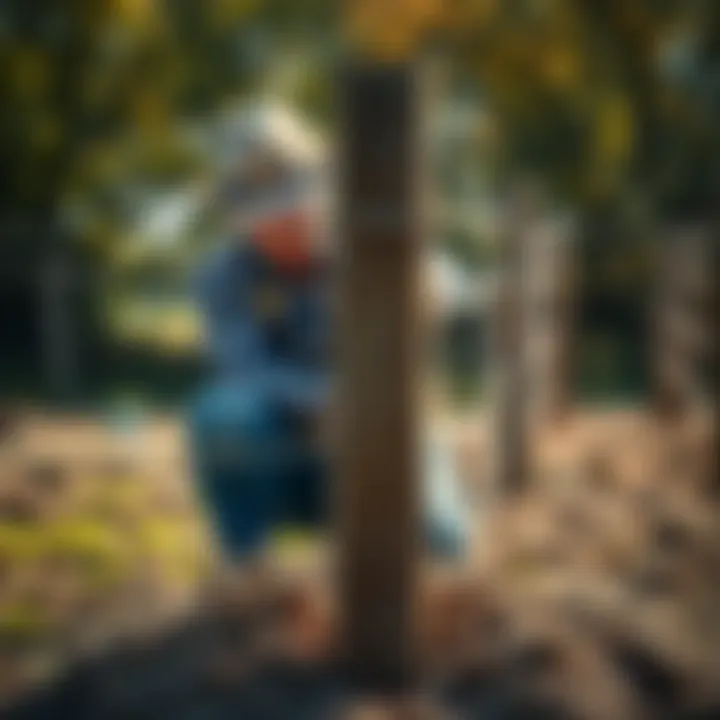
Preparing the Site
Assessing Ground Conditions
Assessing ground conditions is crucial before you break any ground. It allows you to evaluate soil type, drainage, and existing vegetation. This assessment directly contributes to the attractiveness and overall durability of your fencing. One of the key characteristics of assessing ground conditions is learning how compact or loose your soil is. If your soil is primarily clay, you may need to adjust your methods accordingly. Clay can become heavy when wet and could shift posts if not adequately accounted for.
A unique feature of assessing ground conditions is that it helps inform decisions on post material and design. For instance, in sandy soil, wooden posts might decay quickly, while metal posts could be a beneficial choice. But if you go for metal, you'd have to think about corrosion resistance as well.
The advantages here are clear: assessing your ground means you’re less likely to face issues down the line, such as leaning posts or uneven fencing.
Marking the Perimeter
Marking the perimeter is about defining the actual space where the fence will stand. This crucial step allows you to visualize the boundary clearly before installing any posts. One of the key characteristics of marking the perimeter is ensuring your fencing line is straight and true. Having a clear visual guideline helps mitigate errors that could lead to costly adjustments later.
A unique feature of perimeter marking is its potential for planning additional features, like gates and access points, based on how your land flows. But there are disadvantages: a hasty or imprecise marking can lead to misalignment during the installation phase.
Overall, marking your perimeter accurately does more than secure your livestock; it enhances the visual appeal of your property.
Installing Fencing Posts
Stabilization Methods
Stabilization methods are an essential aspect of installing fencing posts because they ensure that your fence stands the test of time. The most common stabilization techniques include using concrete footings or compacting dirt around the posts. A key characteristic of effective stabilization is preventing posts from shifting over time, especially under the pressure of livestock.
Concrete footings can provide the utmost stability, particularly in areas prone to extreme weather, such as heavy winds or frost heaves. However, using concrete can also present some downsides; it can be more labor-intensive and may raise your initial costs.
Another noteworthy aspect of stabilization is the depth at which you set your posts. Deeper placements generally lead to better stability but require extra digging and planning, which may not be suitable for every terrain.
Correct Depth Placement
Correct depth placement refers to how deep your posts should be set into the ground. This can significantly influence the strength and stability of your fencing system. A key characteristic of correct depth placement is that it varies based on the type of post and the local climate.
For wooden posts, setting them at least one-third of their length into the ground is generally advisable. This guideline serves to anchor them effectively and deter uplift during severe weather conditions. However, miscalculating the depth of placement can result in a loose post that leads to all sorts of issues, such as a sagging or leaning fence.
Overall, proper depth placement not only extends the life of your fencing system but also elevates the safety and efficiency of your livestock management.
Maintenance of Fencing Systems
Proper maintenance of fencing systems is critical in sustaining an effective livestock management operation. Fencing serves as the first line of defense against unwanted intrusions and as a means to effectively manage grazing patterns. Regular upkeep not only prolongs the life expectancy of the fencing but also ensures the safety of the livestock involved and optimizes productivity on the farm.
Regular Inspections
Regular inspections are a proactive step in maintaining the integrity of fencing systems. By routinely assessing the condition of the fence, farmers can spot potential issues before they escalate, ultimately saving time and resources. This practice gives a clear view of the overall health of the fencing system and highlights any necessary repairs that may be looming on the horizon.
Identifying Weak Points
Identifying weak points in a fencing system is like finding the cracks in a dam before it bursts. Fences can deteriorate over time due to various factors, including weather conditions, animal interactions, and material fatigue. Spotting these vulnerabilities early can greatly contribute to the longevity of the fencing.
Key Characteristics: They often manifest as rusted hinges, sagging wires, or loose posts. This makes them a fundamental component in a risk management strategy for any agricultural endeavor.
Unique Feature: A well-planned inspection approach allows farmers to use a checklist tailored to the specific materials and designs of their fencing. This strategy is advantageous because it enables focused attention on the specific vulnerabilities associated with different types of posts, whether they're wooden, steel, or composite.
Addressing Wear and Tear
Addressing wear and tear is pivotal for the upkeep of any fencing system. As the years roll on, wear is inevitable. Constant exposure to the elements can lead to rotting wood, rusting metal, or fading plastic, which if left unattended, could result in considerable issues down the line.
Key Characteristics: One of the key aspects of effectively managing wear and tear is timely replacement of damaged materials, ensuring the overall structural integrity remains intact.
Unique Feature: Keeping a log of repairs and replacements can serve as a strong management tool. This method allows farmers to predict when more extensive repairs may be needed thus creating a preventative maintenance plan.
Seasonal Preparations
Seasonal preparations are another vital aspect of maintaining fencing systems. Certain parts of the year bring unique challenges that can impact fencing, necessitating specialized attention and preparation before the seasons change.
Winterizing Fencing
Winterizing fencing involves taking steps to protect the integrity of the fencing against harsh winter conditions. Snow, ice, and extreme cold can wreak havoc on fencing if not properly managed.
Key Characteristics: One should reinforce or replace any materials that might crack or break under extreme conditions. This proactive approach is important in ensuring that the fencing stands strong through the season.
Unique Feature: Consider adding a protective coat or treatment to wooden posts to create a barrier against moisture, which can lead to rotting over time, a critical consideration for enhancing the durability of your installation.
Pre-Spring Checks
Pre-spring checks are essential for ensuring that the fencing system is ready for the new growth season. As the weather warms, livestock will likely be more active, leading to increased pressure on the fencing.
Key Characteristics: Inspecting for any damage from winter storms, as well as checking for vegetation that may have overgrown near the fence line, should be treated as routine.
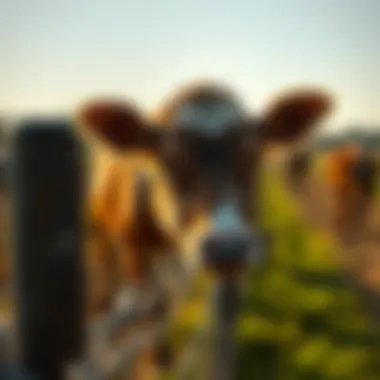
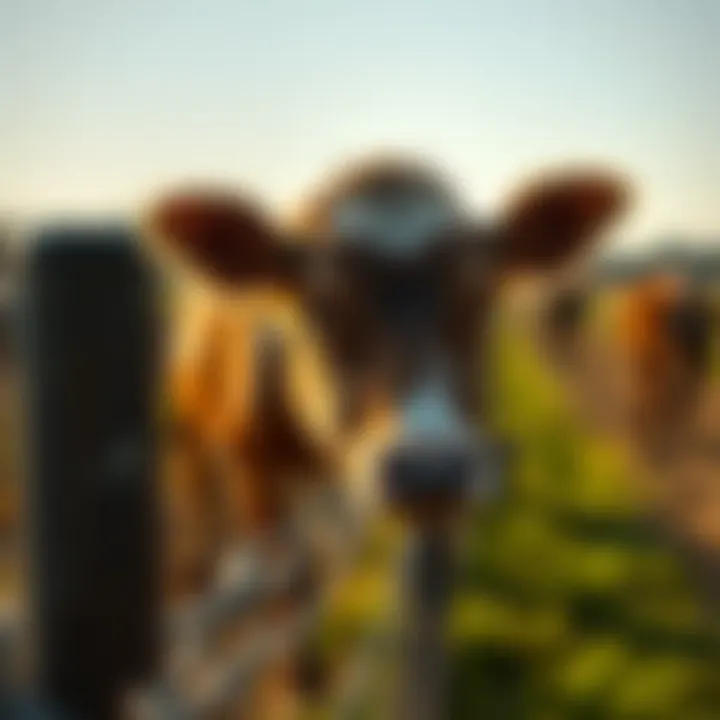
Unique Feature: A checklist that incorporates both general maintenance and seasonal evaluations can effectively streamline this process, ensuring nothing is overlooked that could jeopardize the integrity of the fencing when the livestock begin to roam freely again.
“An ounce of prevention is worth a pound of cure.” Keeping fences in top shape through regular inspections and proactive preparations can save time and money in the long run.
Innovations in Fencing Technology
In the ever-evolving world of agriculture, innovations in fencing technology play a pivotal role in enhancing livestock management. As farmers strive for increased efficiency and sustainability, these advancements become fundamental in addressing various challenges faced in fencing. Today's livestock farming is not just about keeping animals in but ensuring their safety, tracking their movements, and minimizing environmental impact. Let's dive deeper into two significant innovations: smart fencing solutions and sustainable fencing options.
Smart Fencing Solutions
Remote Monitoring
Remote monitoring revolutionizes how farmers maintain their fencing systems. Imagine being able to keep tabs on your livestock from the comfort of your home. This technology enables you to track movement, detect breaches, and receive alerts in real-time, allowing for immediate action when issues arise. The key characteristic of remote monitoring lies in its connectivity—often through mobile apps or dedicated devices—offering not only convenience but also peace of mind.
Farmers appreciate this technology because it minimizes the time spent physically inspecting fences and allows for more time efficiency in managing operations. The unique feature of remote monitoring systems is the use of sensors placed strategically along the fence line. These sensors can detect vibrations or disturbences, notifying you whenever livestock approach or attempt to escape. While initial investment costs can be considerable, the long-term benefits, including more effective livestock management and enhanced security, make it a popular choice among tech-savvy farmers.
Automated Systems
Automated systems further push the envelope in livestock fencing. These systems can include automatic gates or fencing that adjust based on specific criteria, like animal behavior or environmental changes. The highlight of such systems is their ability to operate without human intervention, offering both efficiency and adaptability.
Farmers find automated systems appealing as they reduce labor costs and streamline daily operations. The unique feature is often the integration with smart technology, such as programmable timers and sensors that can control when gates open based on the flock's feeding schedule. However, one must consider the potential risks—reliance on automated systems can create challenges if technical issues arise. Nonetheless, the benefits often outweigh these drawbacks, making them a compelling option for modern agricultural practices.
Sustainable Fencing Options
Recycled Materials
The push for sustainability in agriculture isn't just a trend; it's a necessity. Using recycled materials in fencing aligns with the growing focus on eco-friendly practices. What stands out about recycled materials is their dual benefit: they help conserve natural resources while also reducing waste.
For farmers, recycled materials can offer a cost-effective alternative to traditional fencing options. They often come with a unique durability factor, as many recycled products are designed to withstand the elements just as effectively as their non-recycled counterparts. One challenge, however, is the variability in quality, depending on the source of the recycled material. Despite this, their environmental benefits significantly make them a noteworthy consideration in today’s market.
Eco-Friendly Practices
Integrating eco-friendly practices into fencing solutions is essential in today’s ecological landscape. This includes not only the materials used but also the methods of installation and maintenance. The crucial aspect of eco-friendly practices is that they optimize resource use—taking into account energy consumption and environmental impact.
Farmers embracing eco-friendly practices in fencing can often reduce their carbon footprint, which resonates well with consumers increasingly seeking environmentally responsible products. A unique feature is the incorporation of renewable materials, like bamboo or sustainably sourced wood, both of which offer great aesthetic appeal along with functionality. However, the sustainability aspect comes with considerations around longevity and maintenance costs, which some may find challenging.
The evolution in fencing technology merges practicality with sustainability, laying the groundwork for a new era in livestock management.
Economic Implications of Fencing
Fencing may seem like a mere boundary setting, but when you dig deeper, its economic implications in livestock management are nothing short of profound. Proper fencing not only protects your investment in livestock but can also significantly enhance the overall productivity of your agricultural operation. The initial costs of fencing might appear daunting, but understanding the return on that investment can be eye-opening for farmers and livestock enthusiasts alike.
Several factors must be taken into account when exploring the wider economic consequences:
- Initial Setup Costs: While various materials are available, they come with different price tags attached. Wood may be the more economical choice up front, yet its lifespan is comparatively shorter than steel, which, despite a higher initial investment, may prove more cost-effective in the long run due to reduced maintenance and replacement costs.
- Maintenance Expenses: Beyond initial costs, fencing requires ongoing upkeep. Wooden posts may succumb to rot or insects, while metal options might rust over time. In regions where weather conditions fluctuate, ensuring longevity through regular maintenance is crucial. Think about what repairs might cost versus the potential losses stemming from compromised livestock safety.
- Increased Productivity: A well-fenced pasture creates a safer environment for animals. When livestock are secure, they become less stressed, leading to better grazing habits and optimized weight gain. This increase in animal health and productivity can translate into higher market value.
Ultimately, understanding the economic implications of fencing can steer farmers toward informed decisions that not only improve security but also bolster financial returns.
Cost-Benefit Analysis of Different Systems
A close examination of various fencing systems helps clarify the very real impact on a farm's profitability. Each system comes with its own set of advantages and challenges. Below is an analysis broken down by some commonly used fencing types:
- Wood Fencing
Advantages: Typically cheaper upfront, provides aesthetic appeal.
Disadvantages: Shorter lifespan; higher long-term maintenance costs. - Metal Fencing
Advantages: Highly durable, excellent for long-term use, requires minimal upkeep.
Disadvantages: Higher initial investment, can be less visually pleasing. - Vinyl Fencing
Advantages: Low maintenance and available in various colors and styles; resistant to rot.
Disadvantages: Expensive upfront, potential for cracking in extreme weather conditions.
By weighing these elements, farmers can find a balance between upfront costs and long-term benefits. Investing in fencing that lasts longer and requires less repair can mean fewer headaches down the road.
Impact on Livestock Efficiency and Safety
When it comes to livestock efficiency and safety, the right fencing plays an unparalleled role. A secure, well-designed fence fundamentally influences how livestock operate and thrive. Consider the following aspects:
- Minimized Losses: Livestock escaping due to inadequate fencing can lead to direct financial losses. By preventing breaches, farmers can protect their livestock and their investments.
- Reduced Stress Levels: Animals tend to feel more at ease when they know they are secured within their boundaries. This promotes healthy behaviors, such as grazing and resting, which in turn translate to better health and productivity.
- Effective Pasture Management: With proper fencing, farmers can segment pastures to mitigate overgrazing. By rotating grazing areas, pasture yields improve, extending the life of the land and yielding more forage.
Overall, the economic implications around fencing do not simply reside within the numbers; they trickle down into daily operations, impacting livestock health and farm viability in remarkable ways. Understanding this relationship can empower farmers to make choices fostering sustainable agricultural practices.
If you’re still unsure about investing in an effective fencing system for your livestock, consider reviewing more intricate analyses on platforms like The Spruce or even American Farm Bureau Federation.
As you mull over your options, always keep in mind the long-term benefits against upfront costs; it may just reshape the very way you approach livestock management.
Closure and Future Directions
In wrapping up a comprehensive discussion on livestock fencing posts, it's essential to recognize the increasing significance of effective fencing systems in agricultural practices. The right fencing not only ensures the safety and efficiency of livestock but also enhances farm productivity by mitigating risks associated with animal escape or predation. As farmers evaluate their fencing needs, innovations and future developments in fencing technology are likely to play a pivotal role in shaping livestock management approaches.
Effective fencing solutions are increasingly becoming a cornerstone of modern agriculture. As practices evolve and technology advances, it's crucial for farmers to stay informed about trends that could materially influence their methods. It can be beneficial to reflect continually on best practices, including maintenance protocols and the integration of new materials, to foster a culture of sustainability and efficiency on the farm.
As we steer towards future directions, considerations for more sustainable materials and smarter technologies could be significant. Farmers should also keep an eye on regulatory guidelines that may impact fencing options, such as those promoting animal welfare and environmental stewardship.
"Fencing is not just a barrier—it's a commitment to maintaining a safe haven for animals and optimizing agricultural resources."
Key Takeaways
- Investing in Quality: Higher-quality fencing materials may come with a steeper price but can offer longevity and reduced maintenance costs in the long run.
- Regular Assessment: Farmers should implement regular inspections to address wear and tear swiftly, ensuring continued effectiveness of their fencing systems.
- Sustainability Matters: The switch from traditional materials to more sustainable options like recycled composites can not only help the environment but also resonate positively with customers concerned about ethical farming practices.
Emerging Trends to Watch
- Smart Fencing: Advancements in technology, such as remote monitoring systems and automated barriers, could revolutionize how farms manage their livestock and ensure security.
- Eco-Conscious Solutions: Increasingly, the agricultural sector is moving towards materials that are not only durable but also environmentally friendly, responding to the global push for sustainability.
- Integrated Designs: Future fencing systems that blend aesthetics with functionality may rise in popularity, allowing for seamless integration with natural landscapes while serving agricultural needs.



